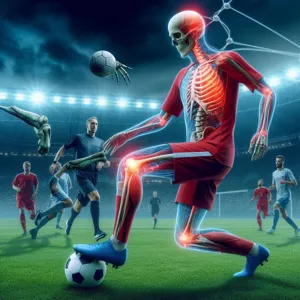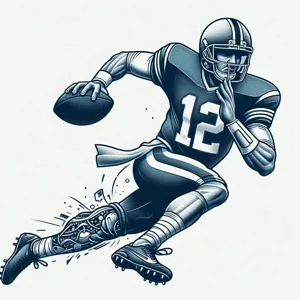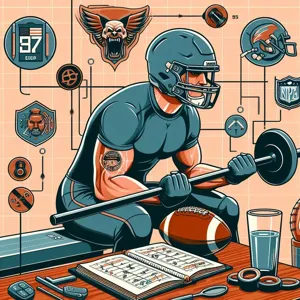For basketball players, stamina and performance are the cornerstones of success on the court.
Whether you’re a seasoned athlete or a weekend warrior, the ability to maintain energy and agility throughout the game can make all the difference between victory and defeat. As the intensity of the game escalates, so does the need for a well-rounded approach to training that not only enhances endurance but also sharpens overall performance. In this blog post, we’ll explore the top strategies to elevate your basketball stamina, from tailored conditioning workouts and nutrition tips to recovery techniques and mental fortitude exercises. Join us as we delve into expert insights and practical advice designed to help you maximize your potential and dominate the court like never before!
1. Understanding the Importance of Stamina in Basketball

Stamina is the lifeblood of any basketball player, acting as the cornerstone of both performance and longevity on the court. Unlike many sports that may allow for moments of respite, basketball is a fast-paced game characterized by continuous movement, explosive bursts of energy, and the need for sustained effort over four quarters. Understanding the importance of stamina in basketball means recognizing that it directly influences a player’s ability to maintain high levels of performance throughout the game.
As the clock ticks down, fatigue can significantly affect a player’s agility, decision-making, and shooting accuracy. A player with superior stamina can outrun opponents, recover quickly after intense plays, and keep their skill level intact even as the game progresses. This endurance allows players to capitalize on scoring opportunities while maintaining defensive pressure, making stamina not just an asset but a crucial component of strategy.
Moreover, stamina is not solely about physical endurance; it also encompasses mental resilience. The mental fatigue that accompanies physical exhaustion can lead to lapses in focus and decreased motivation. Players who invest time in building their stamina develop both their physical and psychological fortitude, enabling them to push through challenging moments and maintain composure under pressure.
Incorporating stamina training into your regular practice regimen is essential for any aspiring athlete. Whether through aerobic conditioning, interval training, or sport-specific drills, enhancing your stamina can lead to improved performance, greater consistency, and a more enjoyable experience on the court. Embracing the significance of stamina in basketball not only prepares you for the game’s demands but also sets the stage for personal and team success.
2. Assessing Your Current Fitness Level
Assessing your current fitness level is a crucial first step in your journey to boost basketball stamina and performance. Understanding where you stand physically allows you to tailor a training program that effectively targets your specific needs and goals.
Start with a comprehensive fitness evaluation that includes various components such as cardiovascular endurance, muscular strength, flexibility, and agility. You might perform a simple cardio test, like a timed mile run or a series of sprints, to gauge your aerobic capacity and overall endurance. Measuring how quickly you can complete these tests will give you a baseline to work from as you progress.
Next, assess your strength through exercises like push-ups, squats, and planks. Note how many repetitions you can perform before fatigue sets in. This will help you identify areas for improvement, particularly in muscle groups vital for basketball, such as your legs, core, and upper body.
Flexibility is another critical factor in basketball performance, as it impacts your range of motion and injury prevention. Incorporate a series of stretches, focusing on key areas like your hips, hamstrings, and calves, and evaluate how easily you can perform these movements.
Lastly, don’t overlook agility. Basketball requires quick changes of direction, so incorporate agility drills such as ladder runs or cone drills into your assessment. Time how long it takes you to complete these drills to identify your starting point.
By taking the time to assess your current fitness level, you’ll not only gain valuable insights into your strengths and weaknesses, but you’ll also establish a solid foundation for creating a targeted training regimen that will elevate your basketball stamina and overall performance on the court. This initial assessment will serve as a benchmark, allowing you to track your progress and celebrate your improvements as you commit to your training plan.
3. Incorporating Cardiovascular Training

Incorporating cardiovascular training into your regimen is a game-changer for boosting basketball stamina and performance. Unlike traditional strength training, which primarily focuses on building muscle, cardiovascular exercises enhance your endurance, enabling you to maintain peak performance throughout the entire game.
When you think of cardiovascular training, running often comes to mind. However, for basketball players, variety is key. Incorporate different forms of cardio that mimic the stop-and-go nature of the sport. Interval training, for example, combines short bursts of high-intensity activity—like sprinting or jumping—with periods of lower intensity or rest. This method not only improves your aerobic capacity but also sharpens your ability to recover quickly between plays, making it invaluable on the court.
Additionally, consider integrating exercises like cycling, swimming, or jump rope into your workouts. These activities strengthen your heart and lungs while reducing the risk of injury associated with repetitive movements. For basketball players, agility is just as crucial as stamina; thus, drills that combine cardio with lateral movements, such as shuttle runs or cone drills, can significantly enhance your foot speed and coordination.
Don’t forget the importance of consistency. Aim for at least three cardiovascular training sessions per week, gradually increasing intensity and duration as your fitness level improves. Remember to listen to your body; it’s essential to balance your training with adequate rest to prevent fatigue and burnout. By weaving cardiovascular training into your overall practice routine, you’ll develop the stamina needed to outlast your opponents and stay sharp as the game intensifies.
4. High-Intensity Interval Training (HIIT) for Basketball
High-Intensity Interval Training (HIIT) has emerged as a game-changer in the world of basketball conditioning. This training method, characterized by short bursts of intense activity followed by brief recovery periods, mimics the stop-and-go nature of a basketball game, making it an ideal choice for athletes looking to elevate their stamina and overall performance.
Incorporating HIIT into your training regimen can significantly enhance your cardiovascular fitness, allowing you to maintain a high level of energy throughout the game. For basketball players, this means being able to sprint down the court, execute quick cuts, and recover swiftly between plays—all crucial elements of the game. A typical HIIT session for basketball might involve exercises such as sprinting, burpees, or agility ladder drills, performed at maximum effort for 30 seconds, followed by 15 to 30 seconds of rest.
What sets HIIT apart from traditional steady-state cardio is its ability to improve both aerobic and anaerobic endurance simultaneously. As you engage in these intense intervals, your heart rate skyrockets, pushing your body to adapt and become more efficient at utilizing oxygen. This adaptation not only boosts your stamina but also enhances your recovery rate, ensuring that you can bounce back quickly after exerting yourself on the court.
Moreover, HIIT workouts can be easily tailored to target specific basketball skills. For instance, you can integrate ball-handling drills or shooting practice into your intervals, making your training sessions more relevant to your performance needs. The beauty of HIIT lies in its flexibility; whether you’re at the gym or on the court, you can modify your routine to fit your environment and available equipment.
In summary, if you aim to boost your basketball stamina and performance, incorporating HIIT into your training plan is a smart choice. Not only will it help you build endurance and speed, but it will also keep your workouts engaging and dynamic, ultimately allowing you to dominate on the court. Start small, gradually increase the intensity, and watch your game transform as your stamina improves.
5. Strength Training for Improved Endurance

Strength training is often overlooked in the pursuit of basketball stamina, yet it plays a crucial role in enhancing your overall endurance on the court. When you think of endurance, you might envision long runs or endless drills, but the secret sauce lies in building a solid foundation of strength. This not only helps you perform better but also reduces the risk of injury, allowing you to stay in the game longer.
Incorporating strength training into your routine means targeting the key muscle groups that basketball players rely on—legs, core, and upper body. Exercises like squats, lunges, and deadlifts will develop the explosive power needed for jumps and rapid sprints. Meanwhile, core exercises such as planks and Russian twists enhance stability, ensuring that you can maneuver swiftly while maintaining balance.
Moreover, don’t just focus on traditional weightlifting; consider employing resistance bands and bodyweight exercises as well. These methods can improve your functional strength, which is critical for basketball movements like cutting, pivoting, and shooting. High-intensity interval training (HIIT) can also be integrated into your strength routines to simulate the stop-and-go nature of a basketball game, effectively boosting both your strength and aerobic capacity.
Consistency is key, so aim for at least two to three strength training sessions per week. As you progress, gradually increase the weights or resistance to continually challenge your muscles. Remember, stronger muscles can endure more, which means you’ll be able to sustain high energy levels throughout your games, maintaining peak performance when it matters most. By committing to a well-rounded strength training regimen, you’ll not only enhance your endurance but also elevate your overall game, making you a formidable presence on the court.
6. Nutrition Tips for Enhanced Performance
Nutrition plays a pivotal role in elevating your basketball performance and stamina, acting as the fuel that powers your body through intense training sessions and high-pressure games. To maximize your capabilities on the court, it’s essential to focus on a well-rounded diet that nourishes your muscles, boosts your energy levels, and aids in recovery.
Start by prioritizing complex carbohydrates, which provide a steady source of energy. Foods like whole grains, brown rice, and sweet potatoes are excellent choices, as they release energy slowly and sustain you through prolonged exertion. Pair these with lean proteins, such as chicken, turkey, fish, or plant-based options like beans and lentils, to support muscle repair and growth. Aim to consume protein-rich meals within 30 minutes after a workout to optimize recovery.
Don’t underestimate the power of healthy fats! Incorporate sources like avocados, nuts, and olive oil into your meals. These fats not only provide essential fatty acids but also help in absorbing fat-soluble vitamins, which are vital for overall health and performance.
Hydration is another cornerstone of athletic success. Dehydration can lead to fatigue and decreased performance on the court, so make it a habit to drink water consistently throughout the day. Consider sports drinks during intense training sessions to replenish electrolytes lost through sweat.
Lastly, timing your meals can significantly impact your performance. Eating a balanced meal 2-3 hours before a game ensures you have adequate energy, while a light snack, such as a banana or energy bar, can give you that extra boost right before tip-off. By focusing on these nutrition tips, you’ll not only enhance your performance but also build the stamina necessary to dominate on the basketball court.
7. Hydration: The Key to Sustained Energy

Hydration is often the unsung hero in the quest for optimal basketball performance. While players may focus on drills, strength training, and tactical plays, neglecting to maintain proper hydration can severely compromise stamina and overall effectiveness on the court. Water is not just a thirst-quencher; it plays a vital role in regulating body temperature, lubricating joints, and transporting essential nutrients to your muscles.
During a high-intensity game or practice, players can lose significant amounts of water through sweat. This loss can lead to dehydration, which can manifest as fatigue, decreased coordination, and diminished reaction times—three critical elements for success in basketball. To combat this, it’s essential to develop a hydration strategy that begins well before game day.
Start by incorporating hydration into your daily routine. Aim to drink water consistently throughout the day, rather than chugging large amounts all at once. A good rule of thumb is to consume at least half your body weight in ounces of water daily. On days of intense training or competition, increase your intake, and consider adding electrolyte-replenishing drinks to replace lost minerals.
Timing is equally important. Drink water regularly during practices and games, not just when you feel thirsty. A good practice is to hydrate before, during, and after physical activity. Consider carrying a water bottle with you to ensure you always have access to hydration.
Monitoring the color of your urine can also serve as a helpful gauge; a pale yellow indicates proper hydration, while darker shades signal the need for more fluids. Remember, staying hydrated isn’t just about comfort; it’s about maximizing your performance on the court. With consistent hydration practices, you can sustain your energy levels, maintain peak performance, and keep your game strong from the first whistle to the final buzzer.
8. The Role of Recovery in Stamina Building
When it comes to enhancing basketball stamina and overall performance, recovery often takes a backseat in many players’ training regimens. However, the role of recovery is paramount. It is during these crucial rest periods that your body repairs itself, replenishes energy stores, and adapts to the stresses of intense physical activity. Ignoring recovery can lead to fatigue, decreased performance, and even injury, effectively derailing your progress on the court.
To optimize your recovery, focus on several key strategies. First, prioritize sleep. Quality sleep allows your body to undergo essential recovery processes, including muscle repair and the regulation of hormones that affect energy levels and mood. Aim for 7-9 hours of uninterrupted sleep each night, and consider establishing a calming bedtime routine to enhance sleep quality.
Next, incorporate active recovery into your training schedule. This doesn’t mean skipping practice but instead integrating lighter exercises such as swimming, yoga, or low-intensity cycling on your off days. These activities promote blood flow and help flush out toxins, reducing muscle soreness and stiffness.
Nutrition also plays a critical role in recovery. After intense training or games, refuel your body with a well-balanced meal rich in carbohydrates, proteins, and healthy fats. Carbs replenish glycogen stores, while protein aids in muscle repair. Hydration is equally important; ensure you’re drinking enough water before, during, and after your workouts to maintain optimal performance levels.
Lastly, consider implementing recovery techniques such as foam rolling, stretching, and even massage therapy. These practices not only relieve tension in the muscles but also improve flexibility and reduce the risk of injury, allowing you to train harder and longer.
By giving recovery the attention it deserves, you’ll ensure that your body is primed and ready to perform at its best, helping you build stamina and excel on the basketball court. Remember, recovery isn’t just a break from training—it’s an essential component of your athletic journey.
9. Incorporating Plyometric Exercises
Plyometric exercises are a game-changing addition to any basketball training regimen, offering a powerful way to enhance both stamina and overall performance on the court. These explosive movements focus on developing your fast-twitch muscle fibers, which are crucial for those rapid bursts of speed and agility needed during a game. Think of plyometrics as the secret ingredient that can elevate your athleticism to new heights.
To effectively incorporate plyometrics into your training routine, start with foundational exercises such as box jumps, depth jumps, and plyometric push-ups. These drills not only improve your vertical leap but also enhance your coordination and balance—key components for maintaining control during intense gameplay. For instance, box jumps require you to engage your core and stabilize your landing, mimicking the dynamic movements you’ll face while navigating the court.
As you progress, consider integrating more complex plyometric routines, like lateral bounds or single-leg hops, which can help develop your lateral quickness and explosiveness. This is especially beneficial for basketball players, who frequently pivot and change directions. These exercises will not only build your stamina but also improve your reaction times, allowing you to outpace your opponents and seize scoring opportunities.
To maximize the benefits of plyometric training, it’s essential to focus on proper technique and form. Quality is more important than quantity—maintaining a strong posture and controlled landing will help prevent injuries while ensuring that you’re engaging the right muscle groups. Incorporate these exercises into your training schedule two to three times a week, allowing adequate recovery time in between sessions to let your muscles rebuild and grow stronger.
Incorporating plyometric exercises into your basketball training can be the key to unlocking your full potential. With consistent practice, you’ll find yourself not only enduring longer on the court but also performing at levels you never thought possible, giving you the edge you need to dominate the game.
10. Mental Strategies for Building Stamina
When it comes to enhancing basketball stamina and performance, physical training is only part of the equation. Mental strategies play a pivotal role in how athletes manage fatigue, maintain focus, and ultimately push their limits. Here are some effective mental techniques that can help you build stamina on and off the court.
First and foremost, visualization is a powerful tool. Picture yourself in the heat of the game, executing plays flawlessly, and outpacing your opponents. By regularly envisioning these scenarios, you can condition your mind to handle the pressure of real-game situations. This mental rehearsal helps to reinforce your confidence and prepares you to perform at your best when it counts.
Another essential strategy is to set specific, achievable goals. Break down your training objectives into smaller, manageable milestones, whether that means increasing your sprint times, extending your shooting drills, or improving your endurance. By focusing on these short-term goals, you’ll create a sense of accomplishment that motivates you to keep pushing forward, ultimately leading to improved overall stamina.
Additionally, cultivating a strong positive mindset is crucial. Train yourself to replace negative thoughts with affirmations of your capabilities. When fatigue starts to creep in during those challenging drills or late-game moments, remind yourself of your training and the hard work you’ve put in. Phrases like “I am strong” or “I can push through” can help shift your mental state and bolster your perseverance.
Moreover, mindfulness and breathing exercises can significantly enhance your mental stamina. Practicing mindfulness can help you stay present and focused during high-pressure moments, reducing anxiety and enhancing your decision-making abilities. Incorporating deep-breathing techniques into your routine can also help control your heart rate and reduce stress, allowing you to maintain clarity and composure on the court.
Lastly, surrounding yourself with a supportive community can provide the encouragement and accountability you need to stay mentally strong. Engage with teammates, coaches, or mentors who uplift and challenge you. Their positive energy can be contagious, pushing you to dig deeper and stay committed to your training regimen.
By integrating these mental strategies into your routine, you’ll not only build your stamina but also enhance your overall performance on the basketball court. Remember, the mind is just as important as the body in the pursuit of athletic excellence.
11. Sport-Specific Drills to Enhance Endurance
When it comes to enhancing your basketball stamina, incorporating sport-specific drills into your training regimen is essential. Unlike general endurance exercises, these specialized drills mimic the demands of the game, allowing you to build stamina while also improving your skills on the court.
Start with the **full-court sprint drill**: this involves sprinting from one baseline to the other, focusing on quick explosive movements. To add a layer of challenge, integrate dribbling to simulate game scenarios. As you sprint, practice changing directions, which not only boosts your cardiovascular endurance but also sharpens your agility and ball-handling skills.
Next, consider the **defensive slide drill**. Position yourself in a low defensive stance and slide laterally across the court. This drill is crucial for developing the endurance needed to maintain your defensive pressure throughout the game. Increase the intensity by incorporating a partner who can simulate an offensive player, forcing you to react and move quickly.
Don’t overlook the value of **shuttle runs**, which involve sprinting back and forth between two points. These runs can be tailored to mimic the distances and movements you’ll encounter during a game. By timing your runs, you can track improvements in your speed and endurance, ensuring you’re always ready for that critical fast break or defensive stand.
Finally, **incorporate interval training** into your routine. This can include alternating between high-intensity drills and short recovery periods, reflecting the stop-and-go nature of basketball. For example, perform a series of layups at maximum effort, followed by a brief rest before repeating. This not only builds your aerobic capacity but also conditions your muscles for the explosive movements required in basketball.
By integrating these sport-specific drills into your training, you’ll not only enhance your endurance but also refine the skills necessary to excel on the court. Remember, the key to building stamina is consistency, so make these drills a regular part of your practice to see significant improvements in both your performance and overall game endurance.
12. Monitoring Your Progress and Adjusting Your Plan
Monitoring your progress and adjusting your plan is crucial for maximizing your basketball stamina and performance. Simply following a training regimen without evaluating its effectiveness can lead to stagnation or even regression. To truly understand how your body is responding, you need to be diligent about tracking your workouts, recovery, and overall performance on the court.
Start by keeping a detailed training journal. Record your daily exercises, including the intensity, duration, and how you felt during each session. Pay attention to metrics such as your shooting accuracy, sprint times, and endurance levels during scrimmages. This data will provide valuable insights into your progress and help identify patterns that may indicate whether your current regimen is working or if adjustments are needed.
Utilize technology to enhance your tracking. Wearable fitness trackers can monitor heart rates, calories burned, and even sleep patterns, giving you a comprehensive view of your physical state. Many athletes find that analyzing this data allows them to fine-tune their training schedules, ensuring they’re pushing their limits without risking burnout or injury.
Moreover, it’s essential to set specific, measurable goals. Instead of a vague aim of “getting better,” outline precise targets, such as increasing your vertical jump by a certain number of inches or improving your mile time. Regularly reassess these goals and adjust your training plan accordingly. If you find that you’re consistently surpassing your expectations, it might be time to increase the intensity or complexity of your workouts. Conversely, if you’re struggling to meet your goals, it may be necessary to scale back and focus on recovery or technique.
Finally, don’t hesitate to seek feedback from coaches or fellow players. They can offer an outside perspective on your performance and provide suggestions that can further enhance your training plan. By actively monitoring your progress and remaining flexible in your approach, you’ll be well on your way to achieving peak performance on the basketball court.
13. The Benefits of Cross-Training
Cross-training is a game-changer for basketball players looking to enhance their stamina and overall performance on the court. While basketball itself is a highly demanding sport that requires agility, speed, and endurance, incorporating a variety of different training modalities can help athletes develop a more well-rounded fitness base.
Engaging in cross-training means diversifying your workout routine by incorporating other sports or fitness activities such as swimming, cycling, running, or even yoga. Each of these disciplines targets different muscle groups and energy systems, allowing you to build strength and endurance without the constant impact stress that comes from repetitive basketball drills. For instance, swimming provides a low-impact workout that builds cardiovascular endurance while also improving flexibility and core strength—essential components for any basketball player.
Additionally, cross-training can help prevent injuries by allowing your body to recover from the high-intensity demands of basketball while still keeping you active. By mixing in different types of workouts, you can reduce the risk of overuse injuries that are all too common in basketball players who focus solely on their sport.
Moreover, cross-training can bring a refreshing change to your routine, keeping you mentally engaged and motivated. This variety not only helps stave off boredom but can also enhance your overall athleticism. As you improve your strength, agility, and endurance through diverse training, you’ll find that your performance on the court becomes more explosive, and your stamina significantly increases.
Incorporating cross-training into your regimen doesn’t have to be complicated. Even just a few sessions a week dedicated to activities outside of basketball can yield substantial benefits. Embrace the variety, and watch as your game reaches new heights!
14. Tips for Staying Motivated and Consistent
Staying motivated and consistent in your basketball training can sometimes feel like an uphill battle, especially as you juggle the demands of life outside the court. However, maintaining your enthusiasm is crucial for boosting your stamina and overall performance. Here are some effective strategies to keep your motivation high and ensure that your training remains a regular part of your routine.
**Set Clear Goals:** Begin by establishing specific, achievable, and measurable goals. Whether it’s improving your shooting percentage, increasing your endurance, or mastering a new skill, having concrete targets gives you something to strive for. Break these goals down into smaller milestones, and celebrate each achievement, no matter how small. This sense of progression can fuel your motivation and keep you focused.
**Create a Training Schedule:** Consistency thrives on structure. design a training schedule that fits your lifestyle and stick to it. By treating your workouts like important appointments, you’ll be less likely to skip them. Incorporate a mix of drills, scrimmages, and conditioning workouts to keep things fresh and engaging. Remember to include rest days; recovery is just as crucial as training itself.
**Find a Training Buddy:** Surrounding yourself with like-minded individuals can significantly enhance your motivation. Find a training partner or join a local league to foster camaraderie and accountability. Training with someone else not only makes workouts more enjoyable but also pushes you to give your best effort, knowing that someone else is counting on you.
**Track Your Progress:** Keep a training journal or use fitness apps to track your workouts and progress. Monitoring your development helps you see how far you’ve come and can reignite your passion when motivation wanes. Documenting your journey can also serve as a powerful reminder of your commitment and hard work.
**Diversify Your Training:** Routine can lead to burnout. To keep your training exciting, diversify your workouts by incorporating different drills, exercises, or even cross-training activities like swimming or cycling. Exploring new skills, such as ball-handling or defensive techniques, can reignite your passion for the game and enhance your overall performance.
**Visualize Success:** Take a moment before each practice or game to visualize your performance. Picture yourself executing perfect shots, making strategic plays, and exhibiting peak stamina throughout the game. Visualization can enhance your confidence and mentally prepare you for the challenges ahead.
**Reward Yourself:** Set up a reward system for yourself. After reaching specific milestones or consistently sticking to your training schedule, treat yourself to something you enjoy—be it new gear, a favorite meal, or a day off to relax. These rewards can act as incentives, keeping your motivation levels high.
By implementing these tips, you’ll find that maintaining motivation and consistency in your basketball training becomes a more manageable and enjoyable endeavor. Remember, the journey to improved stamina and performance is a marathon, not a sprint; stay committed, and you’ll reap the rewards on the court.
15. Conclusion: Putting It All Together for Peak Performance
In conclusion, achieving peak performance on the basketball court requires a holistic approach that encompasses physical conditioning, mental resilience, and strategic gameplay. By integrating the strategies discussed throughout this article, you can significantly enhance your stamina, agility, and overall performance.
Start by establishing a consistent training regimen that focuses on building your aerobic capacity through interval training and endurance exercises. Incorporate strength training to develop the explosive power needed for those crucial jumps and quick lateral movements. Don’t forget the importance of flexibility and mobility; a well-stretched body can greatly reduce the risk of injury and improve your range of motion, allowing for fluid movement during games.
Equally important is nurturing your mental game. Visualization techniques and mindfulness practices can sharpen your focus, helping you to stay calm under pressure. Setting specific, measurable goals not only keeps you motivated but also provides a clear roadmap for your training journey.
Lastly, listen to your body—adequate rest and recovery are just as essential as the workouts themselves. Proper nutrition, hydration, and sleep will fuel your body and allow you to perform at your best when it counts.
By combining these elements into a cohesive strategy, you’ll not only boost your stamina but also elevate your entire game. Remember, success in basketball is not just about the hours you put in on the court; it’s about the smart choices you make both in and out of season. Commit to this comprehensive approach, and watch as your performance transforms, leading you to new heights on the court. Embrace the journey, and enjoy the game!
In conclusion, enhancing your basketball stamina and performance requires a well-rounded approach that incorporates physical training, mental resilience, and proper nutrition. By implementing the strategies outlined in this article, from interval training and strength conditioning to mindfulness techniques and hydration practices, you’ll not only elevate your game but also enjoy the process of becoming a better athlete. Remember, every player has the potential to improve; it’s about consistency and dedication to your goals. So lace up your sneakers, hit the court, and embrace the challenges ahead—your best performance is just around the corner! We can’t wait to hear about your progress and victories on the court!
























